Ours is an era of discontinuity. The tectonic plates of history are shifting, causing powerful and complicated stresses for nearly every human system — from the family unit to international governance. The U. S. health system is an example of an important, complex system that is under great pressure. In this article, we describe how the organizations comprising this system can be resilient, responsive, and confident in adapting to massive changes by becoming more life sustaining. We present a composite case study to illustrate how the Structural Dynamics approach can be used to achieve this result.
Life-Sustaining Organizations
When talented employees passionately love an organization and hate the idea of leaving it, that organization is most likely life sustaining. Life-sustaining organizations demonstrate commitment to the well-being of their people, their social context, and the natural environment. They have a magnetic quality that attracts highly energetic people aspiring to do great work. These organizations care about the products they make and the people involved in the process of producing and using them. They sustain and improve the quality of their physical surroundings. While certainly imperfect, companies like Apple, Google, and Trader Joe’s are exemplars of complex systems that are guided by life-sustaining principles.
Life-sustaining organizations know themselves to be living organisms that exist within interdependent social, economic, political, and natural contexts. They are responsive and ready to act. These organizations have a highly developed awareness of which forces in their environment deserve their full attention, enabling them to focus on what matters. By continually nurturing their people, their environment, and themselves, they are able to adapt in order to survive and thrive in the world that is emerging rather than remaining tied to an outdated paradigm.
Living systems are able to evolve without losing their identity. Their principles, values, and purpose endure even as their organizational form, processes, and products change over time, sometimes substantially. Life-sustaining organizations seek to sustain healthy functioning at every level and in all activities. These organizations have positive influences on people inside and outside the organization and on the natural environment.
Life-sustaining organizations intuitively engage in systems thinking. They nurture and actively strive to retain the talented people they need to adapt and flourish. In a reinforcing cycle, these people spread the word, attracting others like themselves. Living systems understand that their organizational environment, internally and externally, determines individual behavior to a significant degree. Rather than placing blame on individuals, they look beyond immediate causality to discover systemic drivers of issues.
TEAM TIP
Make a plan for exploring the potential impact of emerging trends on your organization — and for designing robust strategies to act swiftly and decisively in response
These organizations exhibit design integrity by creating the environments, processes, and tools required to most effectively achieve desired results. People have no need to “work around” the system. Because the elements of these systems support one another seamlessly, little internal friction exists as they move toward goals. They are oriented toward achieving the results they have defined for themselves. The products and services that emerge from living systems look right, feel right, and perform well. In this way, they are able to achieve the financial returns they need to sustain themselves.
Is the Health System Life Sustaining?
Because the core mission of the health system is to promote well-being, prevent injury and disease, and care for the afflicted, we would expect the organizations that make up this sector to be life sustaining. How well the health system is functioning depends on where and how you look:
- Medical science is making impressive strides in preventing and curing disease. Huge investments are being made in research and development in the health arena.
- The use of advanced technology is significantly improving outcomes. Early testing can identify disease before it becomes acute. Super-computers help doctors match symptoms to rare illnesses. Remote monitoring allows timely and accurate intervention.
- Fitness is an established trend; yoga centers, gyms, and athletic clubs abound. Approaches like acupuncture, massage, chiropractic, and mind/body therapies are gaining wider acceptance.
On the other hand:
- The aging of the population is exacerbating the shortage of skilled medical professionals and healthcare providers. Fewer people are serving a greater demand for services.
- Complexity and inefficiencies make the health system prone to errors that affect patient safety.
- The personal connection between provider and recipient is strained as professionals are driven to spend less time per appointment, patients travel between specialists and facilities in the course of treatment, and records are often missing, incomplete, or inaccurate.
- Costs are soaring.
These are only a few examples that indicate ways in which the health system is unwell. The system is skewed toward addressing illness rather than maintaining health. This focus drives up costs while reducing the overall quality of life. To be life-sustaining, health organizations must continually and consciously make choices that preserve their positive aspects while simultaneously addressing their challenges.
Applying Structural Dynamics to a Health Organization
Let’s consider the case of OneLife Health Insurance (a composite case derived from a series of engagements in the health system). OneLife employs physicians to review claims with an eye to minimizing the amount it pays out. The company spends more on marketing and advertising than its competitors. Policyholders sense a disconnect between the image OneLife projects of itself as a caring company and the response they receive when they need coverage.
STRUCTURAL DYNAMICS
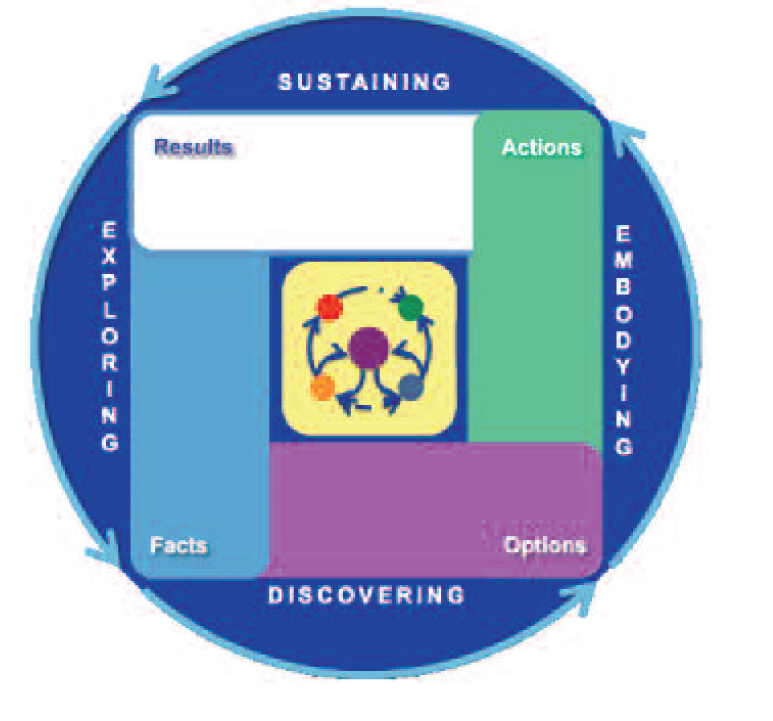
The Structural Dynamics process has four stages: Exploring facts, Discovering options, Embodying action, and Sustaining results.
OneLife understands that its operations may be affected as the large population of Baby Boomers reaches retirement age. In order to engage people throughout the organization in strategic thinking, future analysis, and the integration of strategic direction into day-to-day operations, the OneLife executive committee decides to use Structural Dynamics to investigate the impact of the aging population on the company’s business.
As shown in “Structural Dynamics,” the process has four stages: Exploring facts, Discovering options, Embodying action, and Sustaining results. OneLife begins by convening a team of internal strategic thinkers from all parts and levels of the organization. Company leaders select these individuals for their diverse perspectives on the past, present, and future of the health sector, their willingness to consider views that differ from their own, and their ability to cogently describe their ideas. The team continually communicates with decision makers and colleagues throughout the Structural Dynamics initiative as they:
- Explore a wide range of forces affecting the issue under consideration. The team builds a structural model that represents the dynamics surrounding the issue and identifies a set of divergent, equally plausible future scenarios.
- Discover strategies that work in each of the future scenarios. They choose strategies that work well across the scenarios and/or those that support a particularly appealing scenario.
- Embody the strategies in a way that supports the strategic direction of the whole organization.
- Sustain results by identifying the signposts, indicators, and warnings to monitor and assess. This information feeds back into the process to refine the analysis and deepen the thinking.
The OneLife team formulates the issue they will investigate as: “What services will OneLife provide to the elderly population?” By considering this potent issue before it becomes a crisis, OneLife will be better prepared to make timely, informed choices than competitors that haven’t anticipated the changes on the horizon.
Exploring Facts
The OneLife team proceeds in the Exploring stage of Structural Dynamics by moving through four levels of increasing depth and complexity: events, patterns, structure, and mental models (see “Diving into Complexity” on p. 4).
At the event level, team members respond to the question: “What events, if they happened within the next 15 years, would have a significant impact on the services OneLife provides to the elderly population?” This question might generate hundreds of events. From these, the team identifies the events that are the most critical to the issue under consideration and the most uncertain, usually three to five. The team states these “critical uncertainties” as variables that can move in one direction or another. The OneLife team selects as one of its critical uncertainties: “The health and well-being of the elderly population.” We will use this variable as an example in our description of the process.
DIVING INTO COMPLEXITY
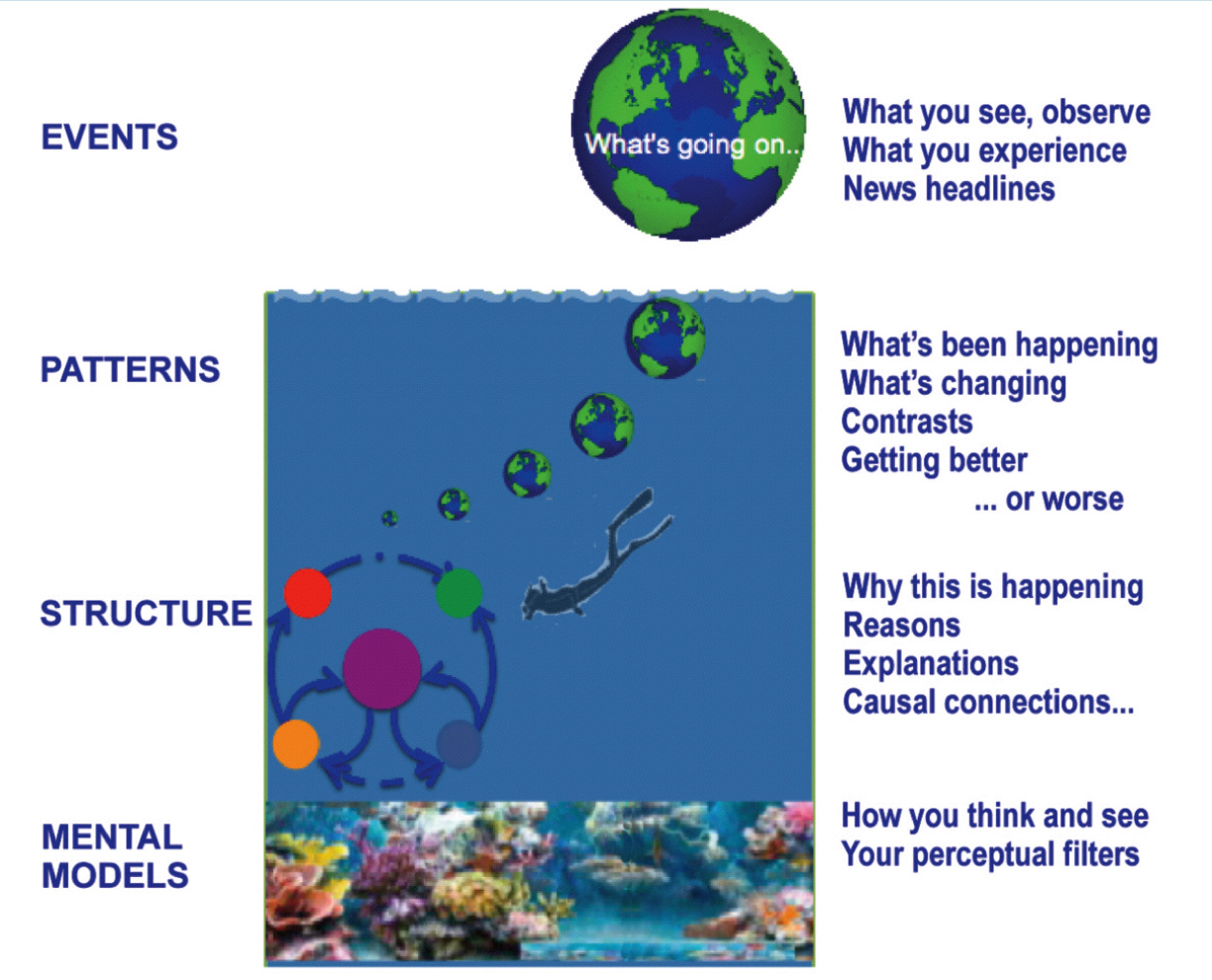
Some of the uncertainty surrounding this variable includes:
- Will the elderly be predominately fit and active?
- Will they tend to be obese and prone to disease?
- Will new discoveries make aging bodies infinitely renewable?
- Will financial need, social isolation, and health concerns combine to create a demographic that is depressed and despairing? (Click here for “Population Demographics.”)
PATTERN 1
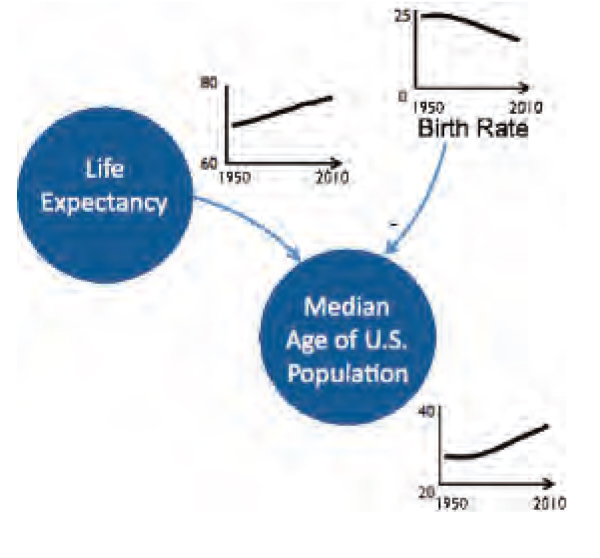
Life expectancy has increased significantly over the last 60 years. Following the Baby Boomer spurt, the U. S. birth rate has been declining. As a result of these trends, the median age of the U. S. population has been increasing.
These questions have no definitive answers.
At the pattern level, the team considers how the critical uncertainties they identified have been trending in the past, using the same 15-year timeframe. These trends cannot simply be projected into the future. The Structural Dynamics model the team constructs will identify forces that could very well shift the pattern in another direction.
Patterns are interconnected variables that repeat under particular circumstances. These chains of cause and effect are responsive to the conditions that exist. As Christopher Alexander said, “The shape of the wave is generated by the dynamics of the water, and it repeats itself wherever these dynamics occur.” Buckminster Fuller stated it this way, “The wave is not the water. The water told you about the wave going by. But the wave has a patterned integrity of its own–absolutely weightless.” The OneLife team identifies patterns of closely related variables (see “Pattern 1” and “Pattern 2” as examples).
PATTERN 2
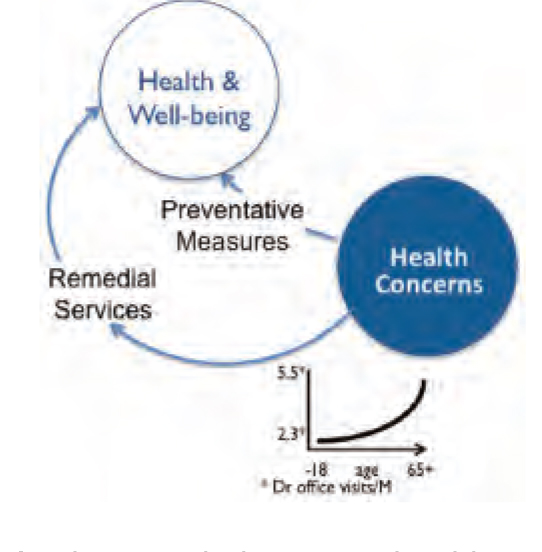
As the population ages, health concerns increase. Historically, people over 65 visit doctors more than twice as often as those under 18. This is one of many factors contributing to exponential growth in healthcare costs, which have risen from 3 percent of GDP in 1950 to approaching 20 percent currently. Myriad choices are available to the aging to maintain (preventive measures) and improve (remedial services) their health. These individual and institutional choices greatly influence the health and well-being of the population.
At the level of structure, patterns link together to form a system. Closing the loop, we see that the health and well-being of the population affects life expectancy. Based on the choices of the elderly and their providers, the health and well-being of the population could stay the same, improve, or decline in the coming years.
A systemic structure has two distinct types of connections: the first based on mathematics and the second based on human choice. “Pattern 1” shows that the combination of increasing life expectancy and declining birth rate results is a rising median age of the population. There’s no choice involved; it’s the simple math of the situation. In “Pattern 2,” we see that human choices (how individuals and institutions balance preventive measures and remedial care) affect the overall health and well-being of the population.
SYSTEMIC STRUCTURE
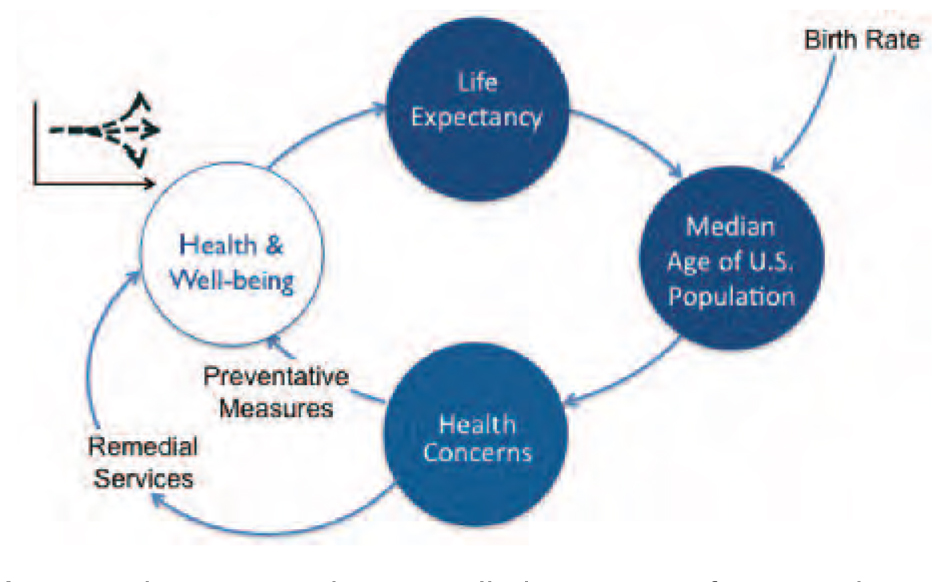
A systemic structure has two distinct types of connections: the first based on mathematics and the second based on human choice.
At the level of mental models, the team probes the assumptions people hold regarding the critical uncertainties. The diverse opinions represented on the team help to insure that OneLife considers a wide range of views. The team looks at the implications of any critical uncertainty using two sets of structural dynamics:
1. Abrupt vs. Gradual Dynamics (i.e., will this critical uncertainty evolve slowly over a long period of time? or… will it change abruptly in a transformational torrent?) is based on mathematical relationships. For example, a snowflake landing on a snowy overhang could add incrementally to the snow mass or that snowflake could be the tipping point, triggering an avalanche that abruptly and significantly changes the landscape. In many cases, we cannot know if or when an abrupt change will occur; however, we still form mental images of the impact of the snowflake that we use as a basis for subsequent actions and decisions. We may not be consciously aware of the many mental models that continually guide our thinking and actions.
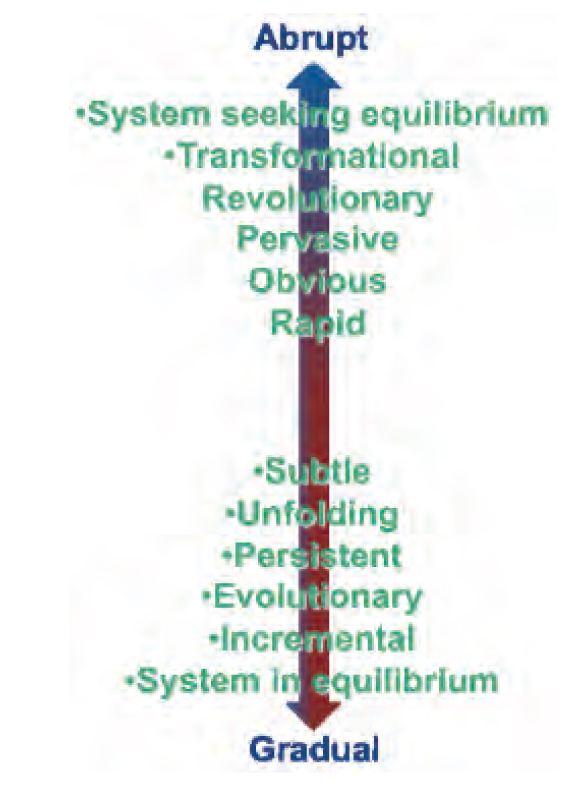
For example, some OneLife team members hold a mental model that the health and well-being of the elderly will have a rapid and transformative impact on the services OneLife provides (, “It’s going to hit us like a ton of bricks!”). Others believe the impact will be more gradual and evolutionary (, “We’ll muddle through.”).
Regardless of team members’ views of the rate of change, the physics of the situation will be what it will be. If OneLife is not aware of and testing its view of the impact that the health of the aging population will have on the services it provides, it will be blindsided by surprises for which it is unprepared. The team is charged with identifying and communicating the full range of possibilities. OneLife will then be able to position itself to deal with whatever happens.
2. Conserve vs. Expand is based on human choice. Faced with the possible occurrence of a critical yet highly uncertain event, we can choose a conservative stance. We can hunker down and attempt to preserve what we have or we can be expansive: treating the eventuality as an opportunity to make needed changes.
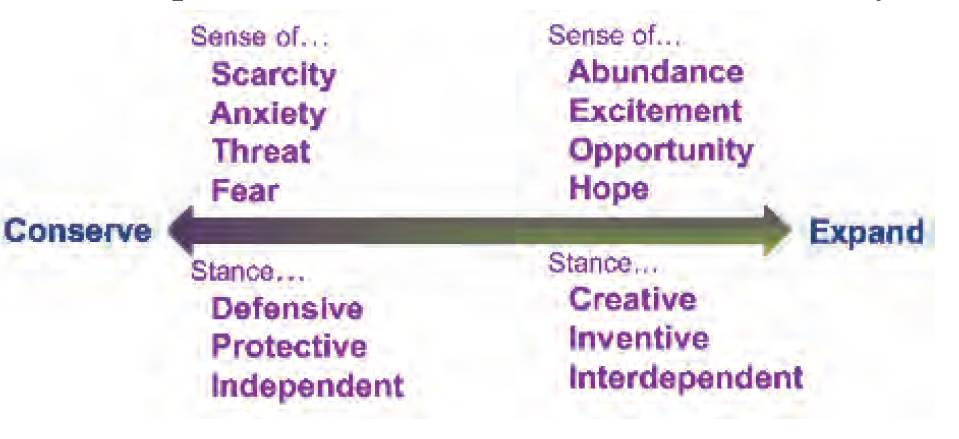
The figure below shows the possible human stances toward critical uncertainties, ranging from fear to hope. Both stances are natural, situationally appropriate, and understandable. OneLife might see the impact of the health and well-being of its elderly policyholders with anxiety, e.g., too many elderly people needing too much care. If so, it may take a conservative stance to protect its resources and preserve its current methods of operation. On the other hand, OneLife can choose an expansive stance, repositioning its operations and services to meet the impending demand.
At this point in the initiative, OneLife begins to see that they have tended toward a stance of preserving and that they have the choice to be expansive — offering services that would attract additional customers. In fact, they understand that their current methods are having an unintended effect, as customers are being drawn away to more responsive competitors.
Overlaying these two axes, we get four quadrants (see “Scenario Game Board”), each representing a unique future scenario. While we recognize that an infinite number of future possibilities exist, grouping them allows us to analyze starkly different futures. In discussions with Jim Dator at the University of Hawaii’s Research Center for Futures Studies, we started thinking in terms of archetypal scenarios. An archetype represents something that many people respond to at a visceral level as if recognizing a basic truth, something they’ve always known or believed.
SCENARIO GAME BOARD
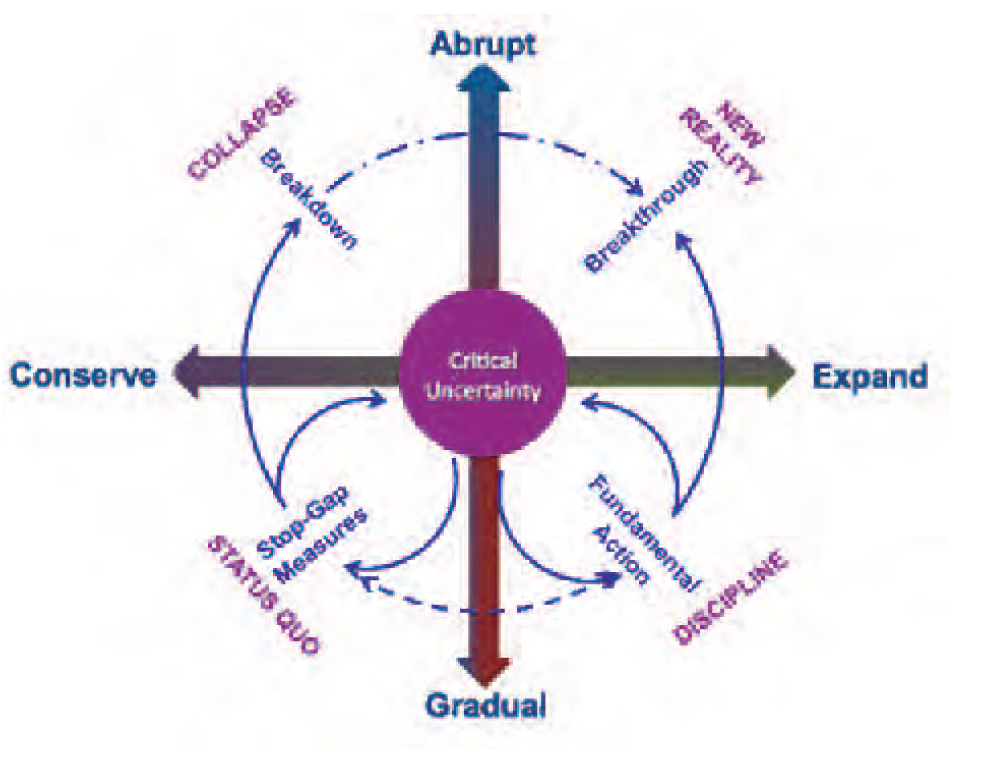
Each quadrant on the Scenario Game Board represents a unique future scenario.
The four scenarios that emerge from the intersection of these dynamics represent the images of the future held by people across cultures and over time that Dator and his associates identified. Building on their work, four archetypes emerge to describe distinct future scenarios:
Status Quo: The future emerges gradually from the present. This scenario occurs when critical uncertainties unfold relatively slowly and steadily. Organizations and societies are able to take stop-gap measures to solve any problems that arise. The OneLife team sees this scenario world as one in which the health system remains basically the same. As issues arise (e.g., professional burnout, more costly treatments), steps are taken to fix the problem.
Discipline: This future is characterized by investment and invention. Critical uncertainties unfold gradually, and a lot of “can do” energy exists. A variety of technologies and methodologies emerge to meet the needs of the aging population.
New Reality: Huge breakthroughs result in a world radically different from the one we’ve known. In this scenario, one or more abrupt changes results in dramatic new conditions. OneLife envisions genetic medicine in this world, which might extend life expectancy to 100+ years.
Collapse: In this future, social, economic, and environmental systems break down. People react by doing the best they can for themselves, their families, and the organizations they depend upon. OneLife posits a global epidemic resulting in the death of many millions; the survivors are unable to maintain the complex health system that sustained them in the past. Life expectancy declines.
“Scenario Outlines” is an overview of how the OneLife scenarios begin to take shape based on the variable we have been using as an example.
Discovering Options, Embodying Action, Sustaining Results
In this article, we have focused on the Exploring stage of Structural Dynamics. In the next stage, Discovering, to enrich and deepen their understanding of the forces in play and how they impact one another, the OneLife team integrates the Game Boards of all of the critically uncertain variables that they have been investigating. The team tries on life in possible future worlds. They use their insights to develop strategies within each scenario and test them. Some strategies will be robust, viable across all the scenarios. The applicability of other strategies may be contingent on the nature of the future that emerges.
In the Embodying stage, OneLife adopts a strategy that integrates the promotion of nutrition and exercise, particularly targeted toward people over fifty. It implements this strategy broadly, both within the organization as well as in its customer policies. Employees who smoke or are obese receive support in meeting specific targets. Working with nutritionists, the company’s food service team dramatically improves the offerings in the cafeteria. To encourage employees to bike, carpool, use mass transit, or walk to work, OneLife facilities charge employees for parking cars. With the reduced number of cars onsite, the company turns paved areas into green space over time.
SCENARIO OUTLINES
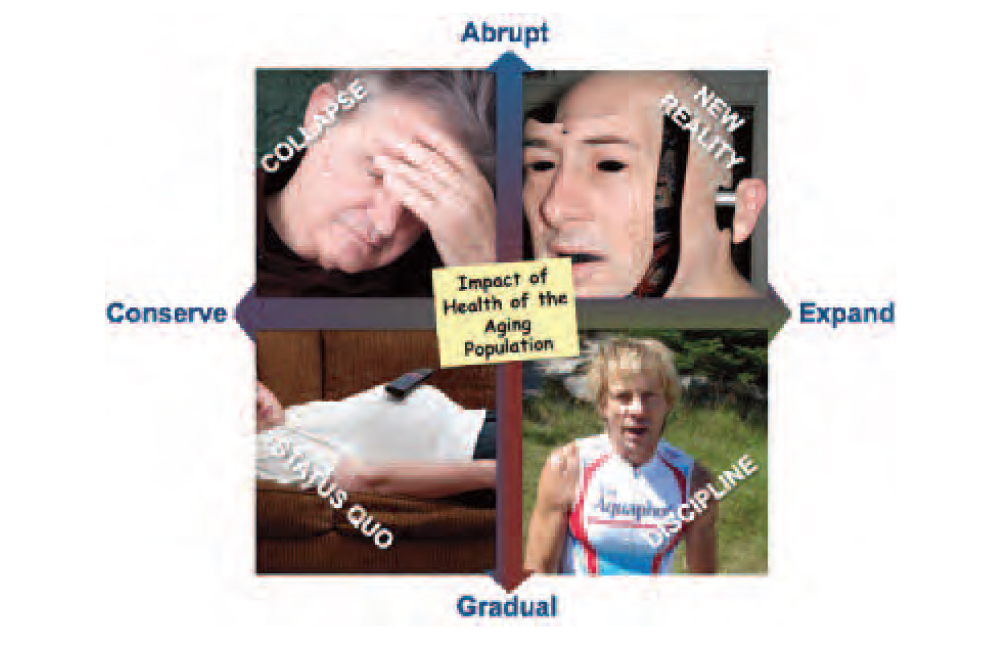
Status Quo — Seniors seek medical advice and intervention often for a number of ailments. Their prolific medications have side-effects that require additional meds.
New Reality — Replacement human “parts” are common, monitoring is ubiquitous, and health choices are inexpensive and non-invasive. Life expectancy increases dramatically.
Discipline — Seniors are living longer, healthier lives as they tend to eat organic food, exercise, and avoid smoking, obesity, and other known causes of health issues.
Image credits: Collapse—iStock File #: 3145606 by Eurobanks; New Reality—WikimediaFile: Cyborg from flickr.jpg; Status Quo —iStock File #: 3591896 Spaulin; Discipline—by permission of Gary Passler.
Physicians in OneLife’s provider network are encouraged to move patients to healthy choices; they are compensated based on their success in meeting these goals. Subscribers who make healthy choices receive generous benefits, including free fitness classes. OneLife forms marketing partnerships with grocers who offer nutritional services that meet OneLife’s criteria. The company makes preferential arrangements with drug stores that don’t sell cigarettes. It forms alliances with senior centers that place a priority on physical exercise. OneLife also becomes a prominent sponsor of municipal, regional, and national recreational facilities and programs to promote exercise. As a result, OneLife repositions its brand and attracts the most active and fit seniors.
In the Sustaining stage, OneLife monitors the effectiveness of these initiatives by continuously observing signposts, indicators, and warnings that might indicate the need to add, modify, or drop initiatives. Employees at all levels, particularly those who interact with customers, participate in the company’s ongoing monitoring activities. The organization’s boundaries become more permeable, extending into the customer base, the communities OneLife serves, and the natural environment.
A Robust Health System
Looking at OneLife’s learning process, we are reminded that the future is shaped by our collective human choices—at the personal, organizational, governmental, and global levels. The decisions we make influence the degree to which we have the resilience and fortitude to face whatever comes. To what degree will we be oriented toward embracing something new and potentially better? To what degree are we focused on conservation and preservation? Organizations that interrogate the future, probe its many possibilities, and arrive at strategies to pursue a preferred future have the confidence to act swiftly and decisively as threats and opportunities present themselves. Their sense of possibility affects who they are, their interactions with their people, and their orientation toward nature and society. Life-sustaining organizations have boundless horizons for learning, and that keeps them vibrant and relevant! A health system full of life-sustaining organizations vigorously supports the well-being of all.
For a complete description of Structural Dynamics and a comprehensive case study, see Sales and Savage, Life Sustaining Organizations: A Design Guide (Art of the Future, 2011).
Anika Ellison Savage (anika@artofthefuture.com) is co-founder of Art of the Future, a strategic leadership consultancy and co-author of Life-Sustaining Organizations: A Design Guide, which applies Structural Dynamics to help organizations realize their potential as living systems. Anika is a recognized authority on scenario analysis.
Michael Sales (michael@artofthefuture.com) is cofounder of Art of the Future and co-author of LifeSustaining Organizations: A Design Guide. Michael holds an Ed. D. in Organization Behavior from Harvard and is a skilled consultant, executive coach, futurist and educator.
